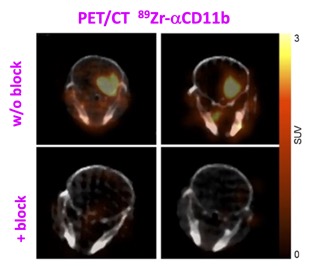Dr. Edwards is currently Associate Professor of Biochemistry, Chemistry, and Radiology at the University of Missouri. He received his bachelor of science degree in Chemistry in 1985 from the University of North Carolina, Asheville. During 1985-1986 Dr. Edwards studied at the Phillips Universität in Marburg, Germany as a Fulbright Scholar. Dr. Edwards received his masters of science in Organic Chemistry from the Florida State University in 1990. He worked in the laboratory of Michael J. Welch from 1990-1994 then he joined the graduate program in Bioorganic Chemistry at Washington University completed his PhD under the direction of Dr. Welch in 1999. His thesis project was the evaluation of radiolabelled peptides for imaging integrin receptors. In 2000, he joined Metaphore Pharmaceuticals in St. Louis, MO where he developed chelators for iron-overload disease and manganese superoxide dismutase mimics for as pharmaceuticals for pain relief. In 2005, he joined the laboratory of Samuel Achilefu as a research instructor at Washington University in Optical Imaging. He was promoted Assistant Professor in 2009 and in 2011 he joined the Radiology Department of University of Pittsburgh. In 2020, Dr. Edwards was recruited to the University of Missouri, where he holds joint appointments in Biochemistry, Chemistry and Radiology as an Associate Professor. His research interests include development of peptide and protein-based probes for theranostics for cancer.

Preclinical PET/CT of GL261 murine gliomas implanted intracranially in mouse brain (trans-axial view) visualized with a Zirconium-89 labelled anti-CD11b antibody. Competitive inhibition with unlabeled anti-CD11b antibody (“+block”) indicates the observed accumulation (“w/o block”) is mediated by CD11b. (Foster et al. eBiomedincine, 2021)
The Edwards lab is actively engaged in the design, synthesis, and investigation of novel molecular imaging agents for molecular imaging of cancer and other diseases. These agents consist of peptides and proteins that are either radiolabeled with radioisotopes for positron emission tomography (PET) or labeled with a near infrared dye for optical imaging or both to delineate tumor margins during surgery.
Our current focus in imaging is to develop informative non-invasive diagnostic imaging strategies to guide immunotherapies for gliomas that will ultimately reduce the use of ineffective therapies, allow patients to attempt more promising personalized treatments, and result in improved response rates.
A second project is to develop dual labeled antibodies to refine neuroblastoma surgery, which is currently limited to detection of tumor by the surgeon’s eyes and hands. A dual-labelled tracer will enable dynamic use of both radio- and fluorescent-guided surgery, taking advantage of the complementary benefits of each, to facilitate safe and complete tumor removal.
Kikuchi M, Clump DA, Srivastava RM, Sun L, Zeng D, Diaz-Perez JA, Anderson CJ, Edwards WB, Ferris RL, Preclinical immunoPET/CT imaging using Zr-89-labeled anti-PD-L1 monoclonal antibody for assessing radiation-induced PD-L1 upregulation in head and neck cancer and melanoma. Oncoimmunology. 2017;6(7):e1329071.
Kim H, Wang X, Kang R, Tang D, Boone BA, Zeh HJ III, Lotze ML, Edwards WB, RAGE-specific single chain Fv for PET imaging of pancreatic cancer, PloS one. 2018;13(3):e0192821
Nigam S, McCarl L, Kumar R, Edinger RS, Kurland BF, Anderson CJ, Panigrahy A, Kohanbash G, Edwards WB. Preclinical ImmunoPET Imaging of Glioblastoma-Infiltrating Myeloid Cells Using Zirconium-89 Labeled Anti-CD11b Antibody. Molecular Imaging and Biology. 2020; 22:685-694.
Foster A, Nigam S, Tatum DS, Raphael I, Xu J, Kumar R, Plakseychuk E, Latoche JD, Vincze S, Li B. Edwards WB, Kohanbash G Novel theranostic agent for PET imaging and targeted radiopharmaceutical therapy of tumour-infiltrating immune cells in glioma. eBiomedicine. 2021;71:103571.
